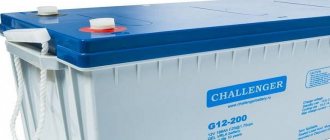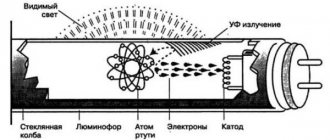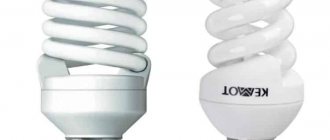Main advantages
For the average motorist, the most important thing is not the ability of a gel battery to work in any position, but its resistance to deep discharge. Let us recall what will happen in this case with a classic battery: as soon as the voltage on the plates of the jar decreases to a critical limit, the reaction of lead sulfate formation begins on the plates, leading to a significant drop in the density of the electrolyte and “fouling” of the plates with a characteristic white coating.
Recently, there has often been talk among motorists about what gel car batteries are, how advisable it is to purchase them, and whether it is true that they last much longer than well-known batteries with liquid electrolyte in their composition. Some people still find it difficult to imagine that such know-how as for cars has long been used everywhere.
Advantages and disadvantages
Drivers are interested in how the new product behaves in operation. Here are her main positive qualities:
Advantages of a gel battery.
- ease of maintenance. It is not required at all - install and use, charging from time to time;
- reliability. Due to the physical characteristics of separators and plates, their shedding is prevented. Acid batteries suffer from this;
- high resource. Gel batteries can withstand 500 – 1000 charge-discharge cycles;
- complete sealing of the battery, eliminating evaporation;
- fast charging. The battery receives a charge faster, since its design uses pure lead, which has lower resistance;
- the battery can operate in any position - the electrolyte in the form of a gel will not spread throughout the case. This is a significant plus if the power source is installed on a motorcycle;
- high starting current, allowing you to easily start the engine, even if the battery charge level is low;
- service life reaching 15 years;
- resistance to deep discharge. They conducted an experiment where they showed that the gel battery withstood about 400 zero discharges. Acidic analogues do not tolerate even 30;
- long self-discharge. If you leave the product in storage, it will lose 15–20% of its capacity over the course of a year, which is relatively little.
Gel batteries have proven themselves to be reliable, but there is a fly in the ointment, so we must take into account their characteristic disadvantages:
- high price. A car battery will cost about 14,000 rubles - for this money you can take 3 - 4 ordinary batteries;
- the need for precise and correct charging. The gel electrolyte is sensitive. And if the generator is faulty or more than 16 V is supplied to the battery, it can easily fail;
- not suitable for use in severe frost. The gel stops “working” even at -30°, so it’s difficult to call gel batteries mobile.
In older cars, such batteries are rarely used, since the generator can fail at any time, and this is critical.
The scope of application of gel batteries is a little from their history
Initially, batteries with a chemical composition in the form of a gel were used exclusively in the aviation industry - to power the on-board systems of aircraft in conditions of constant tilts, turns and sharp turns during flights. In aviation, batteries were needed that could withstand different temperature ranges - from high to very low. In addition, in case of increased danger, it is the thick electrolyte in the form of a gel, obtained through the use of silicon oxide, that is the most optimal form for power supplies.
When the technology for producing these batteries became widespread, their scope of application expanded significantly. They began to be used as power sources for water transport for various purposes. Starting from motor boats and ending with larger vessels. They are especially convenient when used for motorcycles and scooters due to their increased safety, and a gel power source for a car is no longer particularly surprising.
How much do gel batteries cost from different manufacturers?
Now let’s see how much gel battery models cost on the Russian market. Below are prices for models of gel batteries from various manufacturers that are currently offered on the Internet.
Optima
This American company was one of the first to master the production of gel batteries. They mainly produce batteries with roll-type electrodes.
In domestic retail you can find Red, Yellow, Blue models.
Below are the prices for these batteries:
- Red. Positioned by the manufacturer as starter. Price from 15 to 16.5 thousand rubles;
- Yellow. Universal batteries for cars with winches, a large number of current consumers, etc. Price from 14 to 22 thousand rubles;
- Blue. The manufacturer suggests using this series for boats, motor boats, yachts, motor homes, etc. Price from 19 to 24 thousand rubles.
Delta
The production facilities of this company are concentrated in China.
We managed to find 12 volt models in retail. Price range from 6 to 36 thousand rubles.
Models of such series as CT, STC and others produced using AGM technology could not be found on sale.
Varta
The well-known battery manufacturer has several lines of gel batteries in its arsenal.
The following are presented on the domestic market:
- Powersports. These batteries are used on motorcycles. They cost from 3 to 6 thousand rubles. Among them you can find dry-charged models sold complete with electrolyte;
- Funstart. The series is also intended for use on motorcycles. Prices from 2.5 to 10 thousand rubles;
- Silver Dynamic AGM. Batteries for use in passenger cars. Mainly recommended for use on cars with start-stop systems and expensive electronics. Prices from 15 to 22 thousand rubles.
Bosch
Bosch offers S6 AGM HighTec series gel batteries for use in luxury cars with a start-stop system. The issue price ranges from 14 to 16 thousand.
No matter how autonomous a car is, it is still, one way or another, tied to an outlet. The need for a constant source of electrical energy forced the installation of rechargeable batteries under the hood of every car, and their design has remained virtually unchanged over the past hundred years. These are the same lead-acid batteries that convert a chemical reaction into electricity.
Manufacturers and models
Gel products are not afraid of temperature imbalance, are resistant to vibrations, and work in both horizontal and vertical positions. They are practical and their popularity is growing every day. Best car models:
- VARTA Silver Dynamic AGM G14. Made using AMG technology - the electrolyte is absorbed fiberglass. The PowerFrame provides high starting power. Voltage – 12 V. Starting current at -18° – 850 A. Capacity – 95 Ah;
- Bosch S5 A13 AGM. Among the features: terminals protected by a cover, convenient handle for transportation, absolute tightness. Voltage – 12 V. Cold cranking starting current – 850 A. Capacity – 95 Ah;
- Exide Start-Stop AGM EK600. Features: spiral-shaped plates, for use on vehicles with a Start-Stop function, LifeGrid technology - maintaining high energy efficiency throughout its entire service life. Voltage – 12 V. Starting current – 680 A. Capacity – 60 Ah;
- DELTA GX 12-60. A device resistant to deep discharge, suitable for use in a wide temperature range: from -40 to +40°. Voltage – 12 V. Starting current – 600 A. Capacity – 60 Ah;
- Optima Yellow Top. Gel product from an American manufacturer. The starting current value is 765 A.
A gel battery is a valuable and worthwhile purchase. But the battery requires additional investment (additional relay regulator, special charger). The peculiarity is that the electrolyte is in a gel-like state, which provides a lot of advantages, for which, accordingly, you will have to pay. Such a battery will easily last for ten years if you follow the operating rules.
Peculiarities
pros
No maintenance required. Everyone knows what a decrease in the electrolyte level in lead-acid batteries is, the need to find and add water (and not just any water, but distilled water). When using gel batteries, all these problems are eliminated.
Minor damage to the case does not lead to rapid failure of the battery. Again, we compare with traditional batteries. Even a microscopic crack causes the battery to “drain”, as the electrolyte simply leaks out. For gel samples, such damage is not critical due to the thick consistency of the conductive medium.
Gas recombination is almost 100% (for AGM batteries; for GEL models the figure is slightly lower). What does this give? Firstly, they do not come out, and there is no need to constantly monitor the cleanliness of the diffusion hole. It was their contamination that was one of the main reasons why old-type batteries literally exploded.
Gel battery device
The key feature of a gel battery is its electrolyte: unlike other types, here silicon dioxide is introduced into the sulfuric acid solution, which turns the liquid into a gel-like substance. As a result, the electrolyte can be held between the plates in any position of the battery and at the same time serves as a kind of vibration damper: shocks and shaking are practically not terrible for such a battery, while in traditional batteries it is necessary to use elastic plastic separators.
An important difference between gel batteries is their zero gas emission, which is achieved by doping the negative plates with calcium (hydrogen recombination occurs during charge-discharge cycles). A thickened electrolyte does not require space between the plates to remove hydrogen released during charging, and this determines two valuable points at once:
- Firstly, the ability to place the plates with a minimum gap allows you to either reduce the size of the battery or increase its capacity and current output.
- Secondly, it makes it possible to completely seal the battery - more precisely, each can is equipped with a valve set to a certain pressure necessary to trigger the hydrogen recombination reaction. Under normal operating conditions, the valves are always closed, which allows the gel batteries to be considered sealed, but with a sharp increase in gas formation (overcharge), the valves open, protecting the housing from destruction.
When packing a jar tightly, it is not necessary to use the classic design with two parallel plates in each jar. Many manufacturers of gel batteries roll the plates into a spiral, which allows for the most efficient use of space - such energy sources can be immediately recognized by the cylindrical contours of the cans.
Disadvantages of gel batteries
However, it is in the design of gel batteries that their main drawback is hidden: strict requirements for the charging mode. If a classic battery can safely survive multiple excesses of the charging current (for example, in the event of a malfunction of the relay regulator), as long as there is enough ventilation flow rate to remove hydrogen from a “boiling” battery, then for a gel battery such conditions are fatal: gas formation begins to exceed the recombination rate, bubbles hydrogen is retained in the gel, sharply reducing the area of its contact with the plates, then the valves open, releasing excess pressure, and the battery will no longer restore its original characteristics.
Therefore, oddly enough, it is inappropriate to use gel batteries not only on old cars, where generator failure can occur unpredictably, but also on completely new ones. The fact is that modern cars are increasingly moving away from the classical charging scheme, when the relay-regulator maintains a fixed voltage in the network: in them, the generator is controlled by an on-board controller, which is programmed to quickly charge the battery after starting the engine and can, in some cases, significantly increase the voltage in on-board networks.
The second drawback of gel batteries, critical for many motorists, is their price: more complex manufacturing technology makes them much more expensive than AGM and, especially, classic batteries of the same size.
What are the disadvantages of gel batteries?
Despite such a large number of advantages, it is worth talking separately about some of the features and specifics of gel batteries.
It is important to know this before a possible purchase, so as not to be disappointed with the purchase later:
The first thing that can deter a motorist from such an acquisition is the very high price, which remains on the market to this day.
It is known that any battery (and it doesn’t matter whether it is Varta or a product from some other company) costs, on average, 15,000 rubles and more.
How to charge
These devices are completely self-sufficient. However, improper operation or prolonged inactivity can lead to evaporation of the electrolyte and loss of charge. To understand whether it is worth charging a gel battery yourself, remove the battery and check the residual voltage, the indicator should be at least 9 V. The charging process consists of the following steps:
When the voltage reaches 12.5-13.3 V, the device will be fully charged. When charging a gel car battery, carefully monitor the charge level. A slight excess can ruin the part.
How to charge a gel battery on a scooter
Quite often, such devices are installed on scooters. This is due to practicality and convenience. However, oversight leads to discharge. The charging process is not very complicated. You can do everything yourself:
- Buy a charger for sealed lead gel batteries with adjustable current.
- Turn off the scooter.
- Set the charge to 10 percent of the same value of the part (parameters are written on the case).
Typically charging takes about 10-12 hours. To avoid this situation, you need to use a multimeter more often. It helps determine the size of the charge.
Advice! With the right set of skills, you can make a charger for gel batteries with your own hands.
Cons of gel batteries
Why don’t these super technologies become so widespread, because if you believe the manufacturers’ assurances, they are at least three times more effective than conventional batteries, but not everything is so simple in our harsh conditions.
- The very first disadvantage that these options really scream about is the price. Unrealistically high, starting from 15 – 16,000 rubles. For that kind of money you can buy 3 or 4 standard batteries.
- Accurate charge! This is another negative situation; such batteries react very significantly to overcharging. Your generator regulator relay should produce from 14 to 16 Volts (maximum), if the regulator relay is “closed”, then charging will constantly go to the battery, with high rates, even 17 Volts will be enough, which will simply kill the battery. How this happens - the gel that is inside begins to melt like “snow”, but it no longer “knows how” to recover, so this is a loss of capacity, loss of electrolyte, and generally failure. So I would not install such batteries on our old VASES, in which the regulator relay breaks quite often.
- Again, severe frost is also detrimental to the gel. At temperatures from minus 30 degrees, it loses its abilities - it becomes fragile, and also cannot hold the electrolyte with all the “flowing out”. It will quickly fail.
- Some owners, in order not to ruin their “gel-type”, install special electronics on the terminals that monitor overcharges and turn them off if they occur. That is, a kind of double relay-regulator, but more accurate and advanced. It is not cheap, and this can also be attributed to the disadvantages.
So do you need this type of battery?
The question is rhetorical - depending on what you are using it for. If you have a cool new foreign car, you have an extra 15 - 20 thousand, the regulator relay works like a clock, there have never been cold weather in your region - then why not?
If you have an “old penny” (VAZ 2101), the regulator relay gives 12 to 17 Volts, and there are such frosts that it reaches the “forty”! That's definitely a NO! YES and it will cost as much as all this “penny” combined, it’s better to take a regular battery.
That seems to be all, as you can see, there are as many as 11 points of pluses, of course there are fewer minuses, but they are more significant. Think, of course!
Now the video version of the article.
That's all, read our AUTOBLOG, it will be interesting.
Similar news
- Hybrid or calcium battery. Which one is better to choose? Plus …
- Battery starting current. What should it be and what if it is bigger...
- The car battery is frozen. Can this happen and what...
Add a comment Cancel reply
What are the benefits of gel batteries?
As already mentioned, their main advantage is that their internal composition is in the form of a gel. If we compare the degree of safety of such a battery with liquid lead-acid analogues, of course, the gel battery wins in this regard in all directions. It is not afraid of sharp turns and forced changes of position, which expands the scope of its application to universal values.
In addition to safety, there are several more obvious “advantages” of these batteries, which I would like to mention additionally:
- The gel prevents premature destruction of the lead plates of the batteries - thanks to this the battery lasts a long time.
- The lead plates of gel batteries themselves are made from high-quality purified lead, without unnecessary impurities. This also prevents premature sulfation. Due to their low resistance, these batteries charge faster.
- The starting currents of such batteries are much stronger than those of liquid “acid batteries” - as a rule, one and a half times, or even two. This is a very big advantage in harsh winter conditions, when the battery needs to spend much more energy to start the internal combustion engine.
- The gel poured between the plates performs a dielectric function. It prevents them from touching each other and thus ensures the prevention of short circuits.
- Gel batteries do not require adding electrolyte, measuring its density and distilled water, unlike liquid batteries. They are often completely maintenance-free (although there is information that partially serviced versions of them are already on sale).
- Their housing is so sealed and durable that, if necessary, the battery can be placed on its side and even turned upside down. But the manufacturing companies themselves, of course, do not welcome such treatment.
- Their service life, according to manufacturers, is much longer than that of liquid lead-acid batteries. It lasts from six to ten years, subject to proper use.
- If such a battery is not used for a long time for some reason, it retains its optimal capacity much longer and is more resistant to such phenomena as self-discharge.
“Acid” or “gel”?
The answer to this question lies, for the most part, in the financial capabilities and personal preferences of the buyer. After weighing your finances, you can understand what will be most preferable. On the one hand, you should not be afraid of serviceable battery options. Modern acid batteries are also partially serviceable: just fill them once a year with an additional portion of electrolyte or distilled water.
However, in order to determine the density of the liquid inside the battery, you need certain experience, knowledge and skills. In addition, not all drivers accept the need for even such control at the present stage.
If the consumer is not bothered by the high cost of a gel battery, you can purchase it and drive safely. But it is important not to forget about the additional relay-regulator, without which such a battery cannot be installed. Especially when it comes to domestically produced cars.











